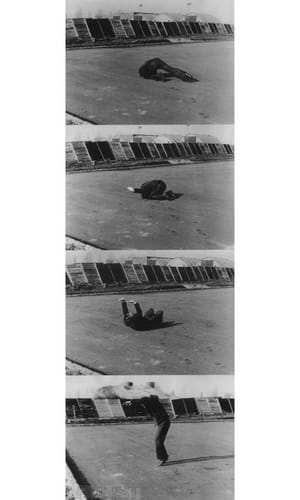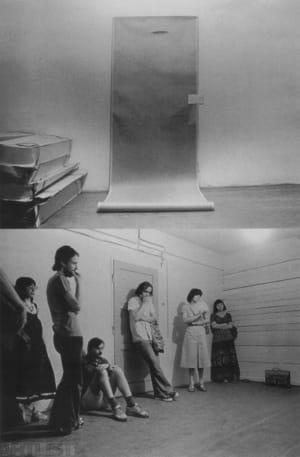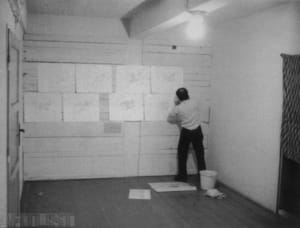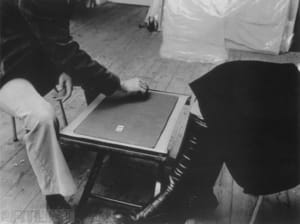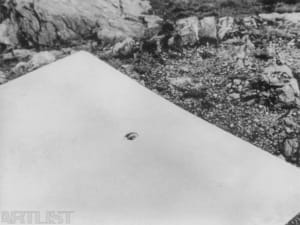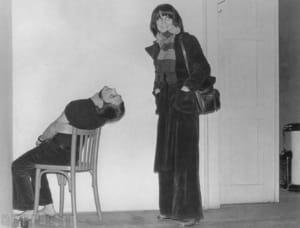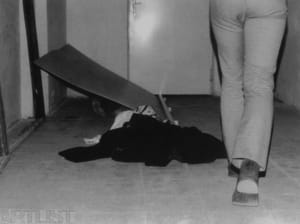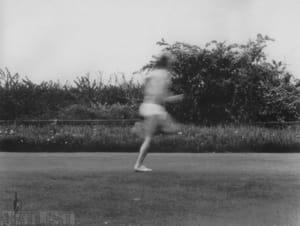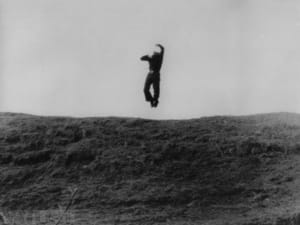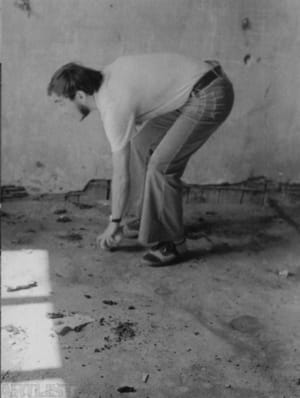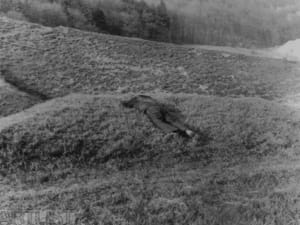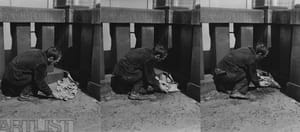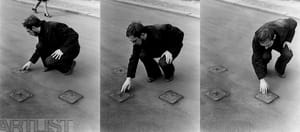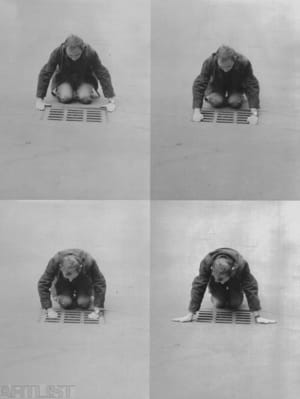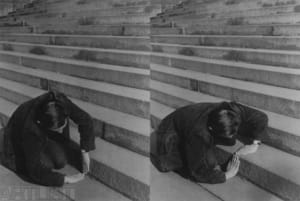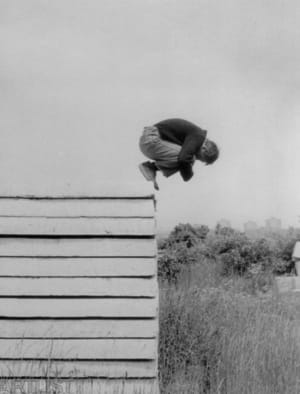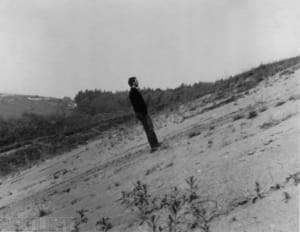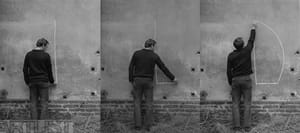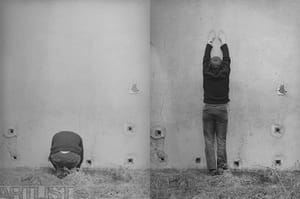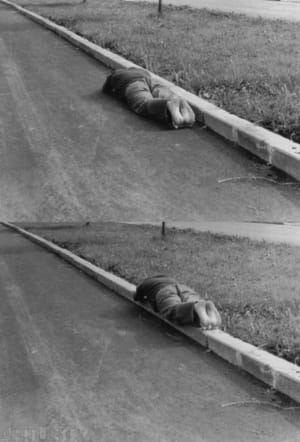- First Name
- Karel
- Surname
- Miler
- Born
- 1940
- Birth place
- Prague
- Place of work
- Prague
- CSU Library
- ↳ Find in the catalogue
About artist
Karel Miler got to doing actions in open space through his own poetry work, which, at the beginning of the 1970s, had a gradually stronger orientation towards conceptual expression. The disengagement of his text from the content led to minimalistic formulations with the simplest antimonies possible. The form became more significant at the expense of the semantic side and the significance of the message was co-created by, for example, the arrangement of words on the page. Miler further developed this principle when he was engaged in placing texts in three dimensional spaces. The piece Either – Or, which interconnected the text and “action” aspects, originated in 1972 in perfect succession to Miler’s previous projects.
Miler’s pieces from the first half of the 1970s reflect the experiencing of one’s own corporeality in space and through photographs they draw attention to the uncertainty of our existence in the world. In addition to other influences, Miler started focusing on phenomenological questions thanks to Jan Patočka’s lectures that he attended during his studies of art history at the Faculty of Philosophy at the Charles University in Prague. Miler distinctly differed from other Czech “action” artists of the 1970s with his approach to photography. His projects in space were actually not meant primarily for the eyes of an audience – his work was not finalized until he produced a series of photographs. During the second half of the 1970s Miler practically abandoned this principle of situations and polarities documented by two, three, four or five photographs with a clearly defined sequence and his work was developing in the direction towards projects with more action. Within a nearly decade the focus of Miler’s work gradually shifted from the theme of human orientation in the world, using photographed situations, towards projects with greater action, in order to get, in the second half of the 1970s, all the way to performances determined for the live public, with which Miler’s work was concluded in 1979.
- Author of the annotation
- Hana Buddeus
- Published
- 2011
Action art played a short but that much more intense role in the life of art historian Karel Miler. He was actively engaged in visual poetry on the turn of the 1960s and 1970s. He was particularly interested in the semantic and spatial context of the language code, which he did not perceive as a testimony about individual feelings but as an independent structure. When he met Petr Štembera in 1971, who was already engaging in physical actions at that time, he realized that it is possible to express semantic word plays with the body. That is how his first action Either – Or (1972) originated, in which he transferred the ideas of his own minimalistic texts to a real somatic level. This thought process led to the creation of Limits in 1973. Again it consists of two body positions of the artist – first the body is curled up to a maximum and then it is completely stretched against a wall. This is an absolutely simple and minimal gesture, which, however, reflects the mystery of the potential of our body. It is evident already from these early attempts that Miler’s disposition is of constructive character and the body art expression is absolutely foreign to him. Even within the scope of body art, Miler worked as a poet; he created conceptual, pointed situations with his body that he captured with the help of a precisely composed camera shot on a tripod. His actions seldom originated in front of an audience. They are some sort of photo-model performances that communicate with the audience only ex post through the medium of a photograph and they do not require further commentary.
Although Miler’s work was being created in the middle of the normalization period – the name for the repressive period of the regime after the occupation in 1968, the paralyzing situation of the Czechoslovak society and culture is hardly present in his actions. Although expressional disengagement and urgency typical for this period is apparent here, the main consideration for Miler is some sort of timeless poetics. This emerged from his admiration of Zen and the desire to find the reflection of the universe in body forms taken to the limits. The body is generalized in his actions; it is released of any dependencies on the common life; it gets to a timeless universal level – like when in the action Identification (1973) a curled up figure falls off a stack of panel boards. The Zen that has been accompanying the author until now influenced his way of thinking in a fundamental way. The Zen philosophy raised coincidence above structure and did not accede to the differentiation between better and worse, beautiful and ugly. According to it everything is connected in unity. It is nicely visible in the piece The Unveiling of the River (1975). There is a peacefully flowing river on the first of the four photographs; Karel Miler is touching the water-laid sand on the second one; the river is washing the sand off the author’s hand on the third; and on the fourth one there is only the river again flowing along undisturbed. The disengagement of this action, as if comes closer to the Zen ideal of clean being. It would be a mistake to look for symbolic meanings of this gesture because one of the goals of the author’s actions is that they should not be symbolically interpreted and that they should not mean anything. As Miler says himself: “Bare facts have the dimensions of the universe.”
A new lyrical charge appeared in Miler’s action in 1976 and it was not only in the titles. The piece Felt by Fresh Grass (1976) stands at the beginning of this set. The author reversed the common situation when people smell flowers and he asked himself a question: “How do I smell to the plant life?” He lay down on a meadow and gave it a unique opportunity to smell and feel a person. The action Closer to the Clouds (1977), in which Miler demonstrated that it is possible to get closer to clouds is done in the same spirit. A person jumps up, nothing more, and he is truly closer to them. The Zen charge also appears in the piece The Holy Self (1977). It is nothing exceptional – the author is just running.
This style of work was in sharp contrast with the official esthetical ideas of the Czechoslovak art direction of the normalization period. It was almost like a private activity that was realized and reflected in a closed circle of kindred spirits. Although this circle around Karel Miler and Petr Štembera decided to end their action work at the end of the 1970s, the work of Karel Miler gained a key position in the context of Czechoslovak post-war art.
- Author of the annotation
- Pavlína Morganová
- Published
- 2011
CV
Studies:
1961-1966 Faculty of Philosophy, Charles University (art history major)
Employment:
1990-1995 contributor to the Lidové noviny daily
1969-1997 worked at the National Gallery
Exhibitions
- Solo exhibitions
-
1978
Galerie Gamma, Utrecht
1977
Byt Petra Rezka, Praha
Stavební fakulta, Praha
1976
Foto+Idea, Galleria Comunale d´arte Moderna, Parma
1975
Umetnik u prvom licu, Salon Muzeju savremene umetnosti, Bělehrad
1972
Veste Sagrada, Rio de Janeiro
- Group exhibitions not included in ARTLIST.
-
(selection)
2009
Tschechische Fotografie des 20. Jahrhunderts, Kunst- und Ausstellungshalle der Bundesrepublik Deutschland, Bonn
2008
Nechci v kleci!, Muzeum umění Olomouc, Olomouc
2007
Prague Biennale 3 - Global and Outsiders: Connecting Cultures in Central Europe, Karlínská hala, Praha
2005
Česká fotografie 20. století / Czech photography of the 20th century, Praha
2002
Corps et traces, Musée des Beaux-Arts, Dijon
2001
Jiří Kolář sběratel, Veletržní palác, NG, Praha
1999
... a co sbírky. Přírůstky Muzea umění Olomouc za léta 1985-1998, Salon, Kabinet, Olomouc
1997
Umění zastaveného času, Česká výtvarná scéna 1969-1985, Brno
Mezi tradicí a experimentem. Práce na papíře a s papírem v českém výtvarném umění 1939-1989, Trojlodí, Olomouc
Umění zastaveného času, Česká výtvarná scéna 1969-1985, Státní galerie výtvarného umění v Chebu, Cheb
Karel Miler, Petr Štembera, Jan Mlčoch: 1970 - 1980, Staroměstská radnice, GHMP, Praha
1996
Umění zastaveného času, Česká výtvarná scéna 1969-1985, Praha
1995
Písmo ve výtvarném umění, Malá galerie Na hradbách, Kolín
1991
Umění akce, Mánes, Praha
1979
Works and Words, De Appel, Amsterdam
Miejsca i chwile, Foto Medium Art (Ośrodka Kultury i Sztuki we Wrocławiu), Vratislav (Wrocław)
1978
Experience Book, Maki Gallery Tokio
1977
Projects/Performances: Czechoslovakia/ Poland, Hallwalls Gallery, Buffalo
Body as a Visual Language, Gallery Maki, Tokio
Oosteuropese conceptuelle Fotografie, Technische Hofeschool, Eindhoven
Vysokoškolský klub Hradec Králové
Cinque artisti cecoslovachi, Studio 16/e, Turín
Karel Miler, Jan Mlčoch, Petr Štembera, Tre artisti cecoslovachi, Laboratorio, Miláno
1976
Karel Miler, Jan Mlčoch, Petr Štembera, Galeria Remont, Varšava
Czeska i słowacka poezja konkretna, Muzeum Narodowe, Vratislav
Příroda Nature, Galerie Institutu průmyslového designu, Praha
1975
Karel Miler, Jan Mlčoch, Petr Štembera, Fiatal müvészek klubja, Budapešť
12 tschechoslowakische Künstler: Von visueller Poesie zu Projekt und Konzeptkunst, EP Galerie, Berlin
1974
1+1, The Students Cultural Center Gallery, Bělehrad
1973
Karel Miler a Petr Štembera, Pécsi Mühely, Pécs
Creative Postcards, New Reform Gallery, Aalst
Karel Miler a Petr Štembera, 65. Avenue Lyautey, Dijon
- Collections
-
National Gallery, Prague
Art Museum, Olomouc
Monography
- Monography
Projects/performances, kat. výst., Buffalo 1977
Gerrit Jan de Rook (ed.), Oosteuropese conceptuele fotografie, Eindhoven 1977
Vlasta Čiháková-Noshiro (ed.), Experience Book, Tokyo 1978
Karel Srp (Ed.), Karel Miler – Možnosti, edice Situace 2, Praha 1979
Bénamou Geneviéve , L´art aujourd´hui en Tchecoslovaquie, Paříž 1979
Works and Words, kat. výst, De Appel, Amsterdam 1980
Jiří Valoch, Fotografie jako dokument a artefakt, 1984
Vlasta Čiháková-Noshiro (ed.), Umění akce, kat. výst., Praha 1991
Alena Potůčková (Ed.), Umění zastaveného času. Akce, koncepty, události, kat. výst., České muzeum výtvarbých umění, Praha 1996
Karel Srp (ed.), Karel Miler, Petr Štembera, Jan Mlčoch (1970 - 1980), kat. výst., GHMP, Praha 1997
Zdenka Badovinac, Body And the East, kat. výst., Cambridge/London 1998
Pavlína Morganová, Akční umění, Votobia, Olomouc 1999
Petr Rezek, Tělo, věc a skutečnost, Praha 2010
- Articles
Flash Art, č. 44-45, duben 1974, s. 5
Flash Art, č. 52-53, únor – březen 1975, s. 32
Vision, č. 2, leden 1976
Flash Art. č. 78-79, listopad-prosinec 1977, s. 21
Milena Slavická – Marcela Pánková (Eds.), Zakázané umění I, Výtvarné umění, 3-4, 1995, s. II
- Personal texts not included in database
Collection of poems:
Alejí slov (Mladá fronta 1995)
K věci (Tvar, 1997)
Konec léta (Alfa-Omega, 1999)
Klíče na trámu / Malé zvěsti (Větrné mlýny, 2001)
Jaderníky (Alfa-Omega, 2004)
